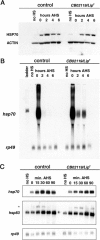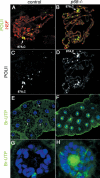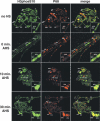The Drosophila P68 RNA helicase regulates transcriptional deactivation by promoting RNA release from chromatin
- PMID: 16598038
- PMCID: PMC1472305
- DOI: 10.1101/gad.1396306
The Drosophila P68 RNA helicase regulates transcriptional deactivation by promoting RNA release from chromatin
Abstract
Terminating a gene's activity requires that pre-existing transcripts be matured or destroyed and that the local chromatin structure be returned to an inactive configuration. Here we show that the Drosophila homolog of the mammalian P68 RNA helicase plays a novel role in RNA export and gene deactivation. p68 mutations phenotypically resemble mutations in small bristles (sbr), the Drosophila homolog of the human mRNA export factor NXF1. Full-length hsp70 mRNA accumulates in the nucleus near its sites of transcription following heat shock of p68 homozygotes, and hsp70 gene shutdown is delayed. Unstressed mutant larvae show similar defects in transcript accumulation and gene repression at diverse loci, and we find that p68 mutations are allelic to Lighten-up, a known suppressor of position effect variegation. Our observations reveal a strong connection between transcript clearance and gene repression. P68 may be needed to rapidly remove transcripts from a gene before its activity can be shut down and its chromatin reset to an inactive state.
Figures







References
-
- Adelman K., Marr M.T., Werner J., Saunders A., Ni Z., Andrulis E.D., Lis J.T. Efficient release from promoter-proximal stall sites requires transcript cleavage factor TFIIS. Mol. Cell. 2005;17:103–112. - PubMed
-
- Aguilera A. Cotranscriptional mRNP assembly: From the DNA to the nuclear pore. Curr. Opin. Cell Biol. 2005;17:242–250. - PubMed
-
- Andrulis E.D., Werner J., Nazarian A., Erdjument-Bromage H., Tempst P., Lis J.T. The RNA processing exosome is linked to elongating RNA polymerase II in Drosophila. Nature. 2002;420:837–841. - PubMed
Publication types
MeSH terms
Substances
Grants and funding
LinkOut - more resources
Full Text Sources
Molecular Biology Databases
